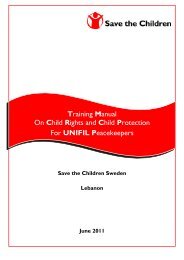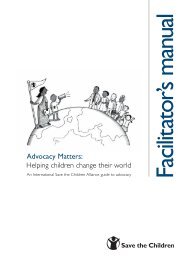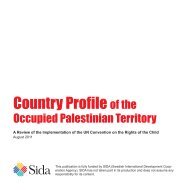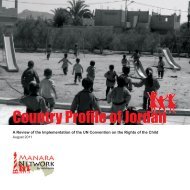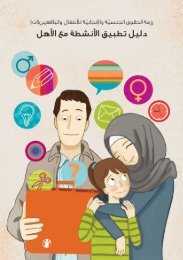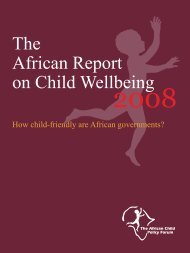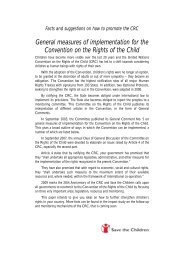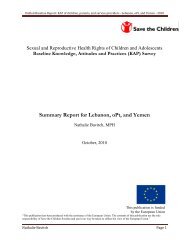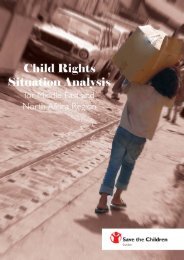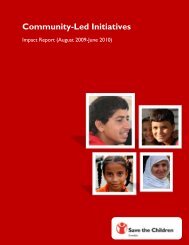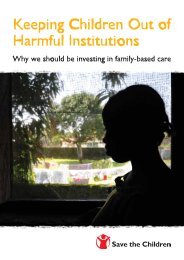Country Profile of Morocco - International Bureau of Children's Rights
Country Profile of Morocco - International Bureau of Children's Rights
Country Profile of Morocco - International Bureau of Children's Rights
Create successful ePaper yourself
Turn your PDF publications into a flip-book with our unique Google optimized e-Paper software.
The Association de Lutte contre le SIDA—Fight against<br />
AIDS Association (ALCS) based in Casablanca provides<br />
a screening service for the general public and organises<br />
many awareness raising campaigns for youth, among<br />
them a popular annual festival.” 126 According to the ALCS<br />
research, less than two-thirds <strong>of</strong> boys and only one-third<br />
<strong>of</strong> the girls are aware condom use can prevent infection<br />
<strong>of</strong> HIV/AIDS, and over 26% <strong>of</strong> reported symptomatic<br />
AIDS cases set in between 15- and 29-year-olds. 127<br />
ii. The Best Interests <strong>of</strong> the Child (Article 3)<br />
In its Concluding Observations <strong>of</strong> 2003, the Committee<br />
recommended that the State take into consideration the<br />
concept <strong>of</strong> the “best interest <strong>of</strong> the child” when reviewing<br />
legislation and administration. 128<br />
The new Family Code reform <strong>of</strong> 2003 sought to take into<br />
account the principle <strong>of</strong> the best interests <strong>of</strong> the child.<br />
Indeed, 22 sections in this Code refer to the principle <strong>of</strong><br />
“interest <strong>of</strong> the child”. 129<br />
However, the Committee specifically expressed concern<br />
over the question <strong>of</strong> child custody, which is determined<br />
by the age <strong>of</strong> the child and not by the interests <strong>of</strong> the<br />
child. Although a positive achievement was made allowing<br />
the child to decide guardianship at a certain age, 130 the new<br />
Family Code provides, through sections 231 and 236, that<br />
“the legal representation <strong>of</strong> minors be exercised by the father,<br />
and is only exercised by the mother in the father’s absence<br />
or following the loss <strong>of</strong> the ability <strong>of</strong> the latter”. 131<br />
Not only do these clauses reflect gender discrimination,<br />
they do not promote consideration <strong>of</strong> the best interest <strong>of</strong><br />
the child in assigning their legal representation.<br />
33<br />
iii. The Right to Life,<br />
Survival and Development (Article 6)<br />
The right to child development is mentioned numerous<br />
times in national legislation. Articles 54 and 510 <strong>of</strong> the<br />
Penal Code, for example, state that parents and custodial<br />
parents must ensure the protection and the right to the<br />
child to develop properly.<br />
a.<br />
Health<br />
As discussed earlier, studies show that the health system<br />
is highly unequal between urban and rural areas. In 2002,<br />
the number <strong>of</strong> Primary Health Structures in <strong>Morocco</strong> had<br />
increased to 2,400 132 from 2,138 in 1999 133 . Nevertheless,<br />
more than 25% <strong>of</strong> the population remains more than 10<br />
kilometres away from a health facility. 134 This is reflected<br />
in the distribution <strong>of</strong> both public and private services. Indeed,<br />
96% <strong>of</strong> private health facilities are located in urban<br />
areas. 135<br />
In 2005, crude birth rates were 20.4 births per 1,000 inhabitants<br />
with a crude mortality rate <strong>of</strong> 5.5 deaths per<br />
1,000 inhabitants. 136 The Total Fertility Rate is 2.4 children<br />
per woman, with a lower fertility rate among urban women<br />
(2.1) than for rural women (3.0). This has gradually<br />
declined from the early 1980s when it was 5.9 children per<br />
woman. 137 This decrease can be explained by a rise in the<br />
age <strong>of</strong> marriage and an increased use <strong>of</strong> contraception.<br />
The mortality rate for children under five remains relatively<br />
high despite dropping from 76% in 1982 to 47%<br />
in 2004. The risk <strong>of</strong> a child dying before the age <strong>of</strong> one<br />
year has been reduced from 149 in every 1,000 births in<br />
the 1960s to 48 deaths for every 1,000 births in 2004. Still,<br />
nearly five in every 100 children die before reaching the<br />
age <strong>of</strong> five. 138




